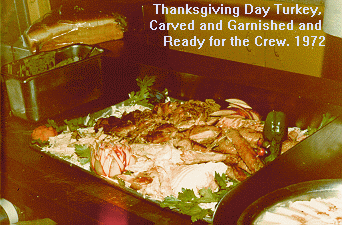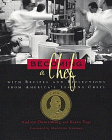
My
Journey To Vietnam
Part 2
By Steve Karoly
In an hour I had gone from a gung-ho, energetic cook to a broken mass of flesh. I searched my mind for every conceivable method to escape reality. I found none. Death appeared near. Think of that, I was dying a slow death at the hands of King Neptune. All I wanted to do was curl up in a ball and sleep away my troubles.
But the crew had to eat.
The cook's job must go on
Performing one task at a time, I bounced between the galley and mess decks (or head) every five minutes. I stopped eating. Even the mariner's standby, saltines and peanut butter, didn't appeal to me. In the galley, I attempted to cook. The mess tables lured me. Laying on the tables presented a much better option than standing in the galley working. By this point any reasonable doctor would have concern for my weight loss. I looked like a hungry, sick cat coming out from the rain.
 I lost all
desire to cook. I prepared supper, consisting of pork
roast, mashed potatoes and gravy, a vegetable and salad,
in record time. I quickly threw the roast in a pan and
seasoned it, tossed the pan in the oven and slammed the
oven door. Retreating to my rack, I attempted to catch a
few hours of shut-eye.
I lost all
desire to cook. I prepared supper, consisting of pork
roast, mashed potatoes and gravy, a vegetable and salad,
in record time. I quickly threw the roast in a pan and
seasoned it, tossed the pan in the oven and slammed the
oven door. Retreating to my rack, I attempted to catch a
few hours of shut-eye.
After a short time, the sound and security watch woke me.
"Cookie," he called, "you'd better get up to the galley. Something's going on up there."
"Go away, I'm sick," I responded.
He persisted. "Get up. The galley's locked. You need to go in and find out what's happening."
Reluctantly, I lifted myself off the deck. "This had better not be someone's idea of a joke," I snapped.
Approaching the galley from the port passage way, I heard pots and pans crashing about. I unlocked the door and braced myself as if I were a Marine charging in to a building. As I slowly opened the door, I saw a pan and two pork roasts rolling about the galley deck. During one of the Cocopa's violent rolls, the oven door gave way and supper flew out.
I charged in, picked up the pan and threw it on the counter. Then, picking up the roast, I quickly washed it, returned it to the pan and put it in the oven. This time I made sure the oven door was secured. Again, I attempted to sleep for a few hours.
Most crewmen avoided dinner that evening. Those who did eat, opted for crackers and peanut butter. A feast waited for the few who braved the storm to eat. I heaped their trays high with food. One engineer told me he enjoyed storms because he could eat all he wanted.
I survived the first day.
My night in the berthing compartment
After securing the galley, I rushed to my rack in the aft berthing compartment. I couldn't wait to get some rest. Saturday seemed like the most fearsome day of my short life.
Flying down the starboard ladder, I hastened for my bunk. My bunk, or rack as we often called them, aligned port to starboard. Those who had bunks arranged fore and aft had a much easier time enduring the pitch and roll of the ship. But I slept facing to port. Each time the Cocopa rolled to port, my mattress slammed into the head of my bunk. On the return to starboard, I hung on for dear life as the sea propelled my mattress and me into the bulkhead.
The ship seemed lifeless that night. Only a dozen men stood watch, manning the bridge and engine room. At eight o'clock, all the lights were off in the berthing compartments. Most crewmen slept. The nightly movie on the mess decks was suspended for the duration. The usual crowd of letter writers and card players had adjourned to their bunks to ride out the storm. The work of the yeomen and storekeepers went untouched. The only engineers and deck gang that were up were those on watch.
This turned into the longest night of the cruise for me. The night lingered on. You can't sleep when you're constantly hanging on for fear you'll be dumped on the deck. When you do fall asleep, it's usually because the ship is riding a wave trough or following the currents. You doze off only to be awaken when the ship slams into the next breaker.
But morning presented me with a new challenge.
The muster report and the bridge
"Karoly," ordered the Leading Petty Officer, "Run the muster report to the OOD."
 Why me, I
thought. But I accepted my fate. Seamen do thing's like
deliver muster reports to the bridge during typhoons.
After all, why send a first class petty officer to the
bridge when an expendable seaman is available. So on the
second day of the raging storm, I set out for the bridge.
Why me, I
thought. But I accepted my fate. Seamen do thing's like
deliver muster reports to the bridge during typhoons.
After all, why send a first class petty officer to the
bridge when an expendable seaman is available. So on the
second day of the raging storm, I set out for the bridge.
Located on the second deck, the Cocopa's bridge violently jerked back and forth. I started up the forward passageway to the bridge ladder. Slowly making my way, I desperately hung on to any object I found. With nothing left in my system to throw up, I fought dry heaves all the way. Starting up the ladder, the Cocopa took a dive to port. Seconds later, I lay prostrate. Quickly, waves jerked to the Cocopa starboard. I hung from the ladder upside down. It took several rolls to reach the bridge.
Gasping for air and clutching my stomach, I announced my arrival on the bridge. Neither helmsman nor the boatswain's mate paid any attention to me. More concerned about maintaining life than watching for visitors delivering muster reports, they kept the Cocopa on course. The boatswain's mate directed me to the bridge wing.
The officer of the deck, a seasoned warrant officer, stood against the old 20mm gun tube sipping his morning cup of coffee. Momentarily standing in the pilot house door, I watched the OOD. Nothing bothered this guy. With every roll, the gun tube skirted the roaring ocean bellow. He didn't pay any attention to the sea and remained calm, watching for on coming ships. Making my report, I handed him the muster and hurried bellow decks.
After my muster report adventure, the second day seemed uneventful. Off duty, I attempted to sleep. Spreading my blanket, I lay on the deck. I wouldn't sleep in my rack if I could help it. The compartment reeked of vomit. Combined with the ever present diesel fumes from the engines, you were just as sick in the compartment as on deck. Although most Cocopa sailors slept when not on watch, I wondered which was worst: stay on deck and suffer the ravages of the storm or try to sleep in a foul-smelling compartment with little air circulation.
Da Nang, Vietnam
Our voyage to Vietnam continued until Wednesday, July 13 when, once again, I stood watch in the galley, this time as we entered Da Nang Harbor. To our left, Monkey Mountain guarded the harbor's entrance. Deep Water Pier, operated by the Army's 277th Supply and Service Battalion, lay ahead. The Cocopa soon anchored out from the piers, delivered her cargo and prepared for our departure the next day. She sailed that same day, setting coarse along the Vietnamese coast for Bangkok, Thailand.
This was the first of three visits to Vietnam that summer. We returned on August 20, 1972, this time delivering packages to an awaiting PBR at Vung Tau. During our voyage north to Da Nang, I celebrated my twentieth birthday cruising off the Vietnamese coast. (I would spend my twenty-first birthday on the USS. Stein (DE-1065) in the South China Sea.) Our final trip to Vietnam consisted of a three week stay in Da Nang Harbor and China Beach as duty tow and salvage in late September and early October.
Although I never traveled directly through a typhoon again, I sailed on the Stein when she successfully evaded a typhoon while in the Gulf of Tonkin in 1973. Experiencing many other storms, I never got as sick as when the U. S. S. Cocopa headed west across the South China Sea toward Vietnam.
As a young sailor, I experienced war in a different manner from that of the foot soldier or PBR sailor. My ship went to war to work, not fight. The Cocopa did many good deeds in Vietnam. She repaired merchant ships, searched for a downed forward air controller near the DMZ and, of course, shuffled small cargo between Subic Bay and Da Nang for the Navy. We saw little combat in those days of Vietnamization. Often, we observe parachute flares or tracers in the distance at night, as we cruised up and down the coast. The VC or NVA, to my knowledge, never fired a shop the Cocopa that summer.
Had I been four years older, my experiences certainly would have been different. I could have been assigned to Cam Rahn Bay, Da Nang, Chu Lai or one of dozens of Navy camps and bases. I may have served with the Mobile Riverline Force or Markettime or deployed as a Seabee.
Yet I am one of the thousands of servicemen and women who served their country, proudly and willingly, who were assigned to the service forces instead of direct combat service. I feel for those who experienced combat, especially ground combat in the jungles of Vietnam. There isn't any comparison between combat and riding a typhoon.
I am thankful I am here today to be a husband to Debbie; a father to Stephanie, Christen and Jacob; and able to serve my Lord some twenty-three years after my tour in Vietnam.
| Bulletin Board | Keyword Search |
| Bookstore | Links |
| About Us | Recent Additions |

